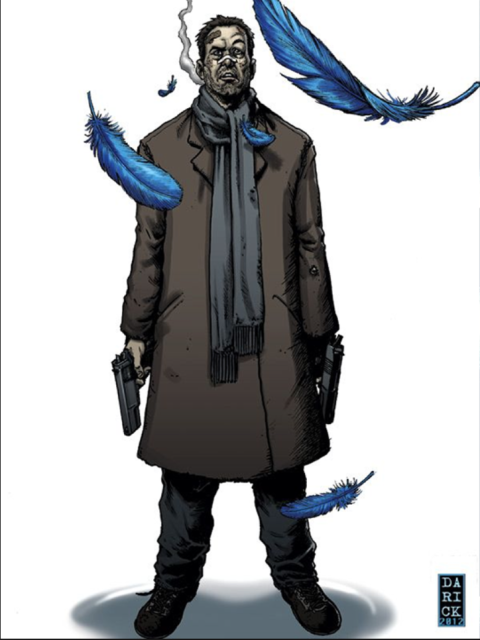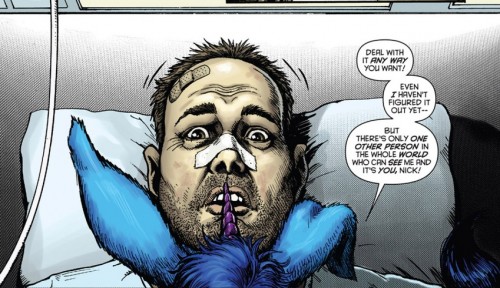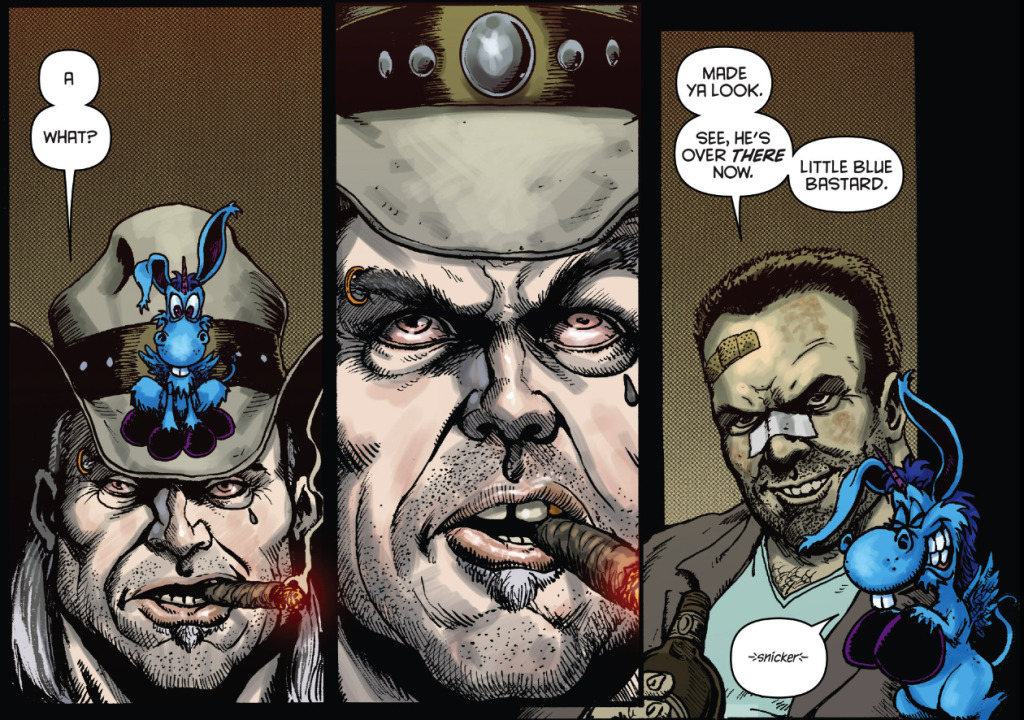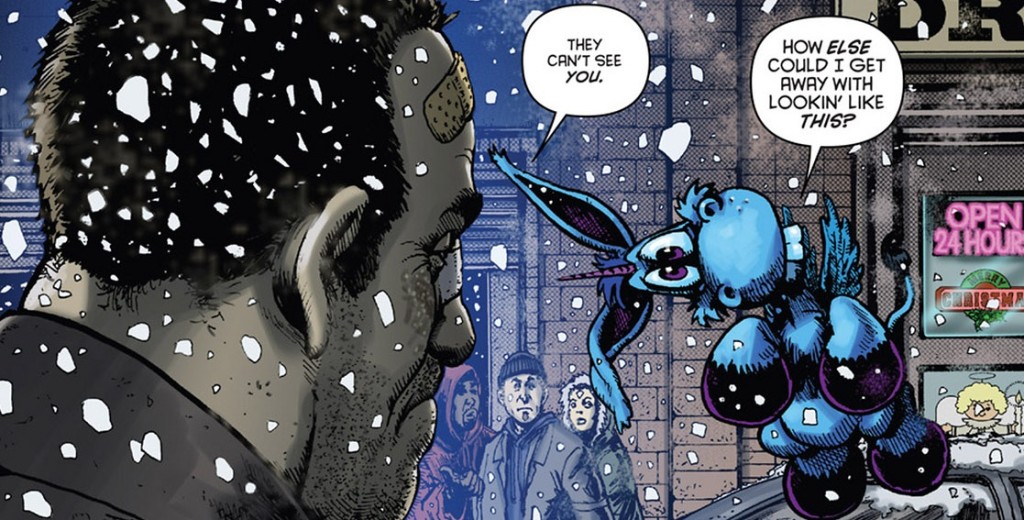Easily the best TV or MOVIE concept I’ve seen all year. But might it be the best concept I’ve seen all decade??
Genre: TV Pilot – 1 Hour Drama
Premise: After a hitman is injured during a job, he wakes up to find a tiny blue horse named “Happy” floating over him, claiming that they’re now a team.
About: Pitched by some as “The Bad Lieutenant meets The Care Bears,” Happy was a four-episode comic by Grant Morrison and Darick Robertson that’s now been adapted for the SyFy Channel. Morrison has brought in Brian Taylor, who’s best known for writing the Jason Statham actioner, Crank, to help him realize his vision.
Writers: Grant Morrison & Brian Taylor (based on the comic with art by Darick Robertson)
Details: 61 pages (Network 2nd Revision – July 27, 2016)
After the depressingly formulaic Rampage, I needed something that was out there, man. I haven’t seen many writers taking chances on the feature end. But there’s plenty of chance-taking on the TV side.
Due to the enormous level of output in TV at the moment, there are two ways to stand out. The first is to buy up a well-known property. Basically, the movie model. And the other is to write something really unique. Today’s script falls into the latter category.
And, actually, today’s script probably has the best screenwriting lesson I’ve discovered in awhile. Because this hook is insanely clever. You see, I read a ton – a TON – of imaginary friend based concepts. It’s the idea every writer goes to when they think they’re writing something original. But today’s script is the right way to do imaginary friends, and the secret to finding a truly original idea.
I’m sure you’re eager to hear more, so let’s jump into it.
“Happy” begins with a creepy teaser. A mother is taking her little girl, Hailey, to see one of those Teletubby-type performances at the local mall. However, with Christmas right around the corner, every family within a 20 mile radius is there as well. That’s how the ultimate parent nightmare occurs. The mother gets distracted for one second… and Hailey is gone.
Cut to a different part of town. Nick Sax is a hitman, and a very un-HAPPY one. We’re told from the drop that this is a man who’s lost everything and has no reason to keep going. But he does. Nick’s just been offered a job to kill the Fratelli brothers, three annoying low-level mobsters.
Sax completes the job, but gets injured in the process. Before he passes out from the injury, a dying Fratelli brother shares with him a password for a drive that contains every single mobster in this city’s secrets.
Sax wakes up in the hospital, but with a new friend. A tiny little blue pony/horse with a unicorn. This is Happy. And Happy is so… HAPPY! He’s excited that Nick’s finally awake. He starts singing to him. He can’t wait for the two to go on adventures together. Nick assumes this is some drug-induced hallucination and waits for it to go away.
Meanwhile, the guy who ordered Sax to kill the Fratellis has ordered someone else to come and kill Sax. But not before he gets that password. Sax is helped by a local female cop, or at least he thinks he is. Not everybody is who they seem, here. And the cop may be working for the guy who’s trying to kill him. Or maybe not!
When the drugs finally wear off, Sax is dismayed to see that Happy the Horse is still around. Sax starts arguing with him, telling him he isn’t into the whole imaginary friend team-up thing. “I never had any imaginary friends anyway,” he tells Happy. Happy chuckles. And that’s when he reveals a bombshell. “I’m not your imaginary friend, Nick. I’m Hailey’s. And I came to you because you’re the only one who can help save her.”
Okay, so let’s break down the genius of this concept. Because if you’re cynical like me, you originally saw the Happy Horse thing and thought, “Zoinks! An imaginary blue horse teams up with a hitman because… COMIC BOOK!”
When that bombshell was revealed that Happy wasn’t Sax’s imaginary friend, but the little girl’s who had been kidnapped in the opening, I was like BSSHSHSHEGGSH! Mind blown. Not just because it was a great idea. But because there was a story-related motivation for Happy to exist.
But let’s get back to the lesson of the day here, specifically the point I originally brought up.
Everybody thinks they’re being creative when they come up with the imaginary friend concept. The problem is, they’re not creative at all. I see tons of them. And they almost always take the same form. An adult is visited by their old imaginary friend from when they were a kid.
Whenever you have an often-used idea, your job is to twist it or elevate it somehow, so that it’s different from everything else out there. The problem is, everybody goes about twisting it the wrong way. They think two-dimensionally when they should be thinking THREE-DIMENSIONALLY.
Two-dimensional thinking is the obvious “next step.” So if you have your “Grown up imaginary friend” setup, a two-dimensional thought might be to make the imaginary friend EVEN CRAZIER! So if the childhood imaginary friend was a bunny, you’d make the bunny a sex-crazed gun-toting wild card! Sounds good, right? But you haven’t really elevated the concept. You’ve just made the imaginary friend a little more interesting.
Three-dimensional thought is when you think beyond what’s right in front of you. You approach the idea from several angles. This is not easy, guys. It’s the quantum computing of idea generation. But that’s why when it works, it results in a killer concept. And that’s what they did here.
This concept is NOTHING if Happy was Nick Sax’s imaginary friend as a child. It’s literally NOTHING. It’s a gimmick. It’s tired. It’s an excuse to get some cool comic book art in. By thinking outside the constraints of that tired setup – what if you were visited by SOMEONE ELSE’S imaginary friend – the idea comes alive. And that’s what happened. And it wasn’t just that it was someone else’s imaginary friend. It’s a little girl’s imaginary friend who’s missing and who needs Sax’s help. Which is why Happy came to him!
I can’t get enough of this idea. I just can’t. This is everything you’re supposed to do with a concept. It’s so damn clever.
And the funny thing about all this is that we don’t get Happy’s reveal until 45 pages in. And before that, I was like, “Eh, this pilot isn’t bad, I guess.” I wasn’t really into it. This is classic noir that, outside of the imaginary friend angle, embraces all the noir tropes a little too eagerly. Which sucks because on concept alone, I’d give this a genius.
So those of you seeing me rave the whole review then only giving this a [xx] worth the read, that’s why. I think this project needs people better than Syfy, no offense. But Syfy has embraced cheese as their curator and this has the potential to be one of the buzziest shows on television with the right people behind it. So I’ll hope that Syfy passes and a Netflix, Hulu, Amazon, or maybe even HBO picks it up. That would be fucking awesome.
[ ] What the hell did I just read?
[ ] wasn’t for me
[xx] worth the read
[ ] impressive
[ ] genius
What I learned: Three-dimensional thinking is hard to define. But the basics work like this. When trying to improve an idea, don’t think “bigger, better, flashier.” Instead, take an omniscient view and look at the idea from all sides to see if there’s a hidden angle you can exploit. They do this in the tech world all the time. Uber is an example. People come in and they say, “How do we make a taxi service that’s better than all the other taxi services out there?” Two-dimensional thinking is: Well, we add TV in the back and we make the cars cleaner and we only hire drivers that are nice and courteous. All that stuff is fine but it doesn’t change the game. Three-dimensional thinking is: Eliminate the taxi altogether.





